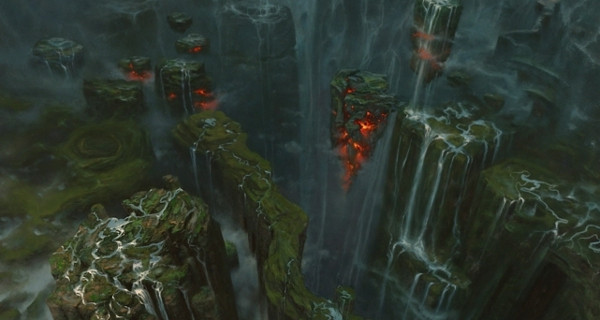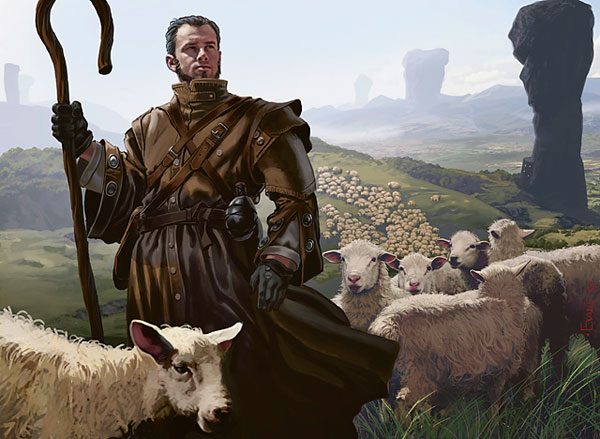Yes sirs, this is my Provocative Order of the week (let's see who gets this).
I didn't even want to hear
the podcast that was incriminated for the "killing of the Warlord in D&D Next", because reading a few comments already made the situation quite clear to me.
Let's state some fundamental points first, about what I disapprove:
- I don't approve arguments against "martial healing": HPs are abstract in the inner workings of the game already, such as their recovery during rests. So yes, Warlords should heal HPs at some point. Or at the very least prevent HP loss pro-actively and/or reactively (which is actually something stronger than healing).
- I don't approve the use of Feats to build a Warlord type of character: it kills differentiation among Warlords. So a Warlord should be viable by selecting in-class options only.
Apart from this, as you may have noticed, I would be quite happy if the Warlord became part of the Fighter class, but my whole point about this matter is that, in my view, it's more the Warlord taking a rightfully earned commanding position between the two classes, and actually BECOMING the new Fighter. Because true, it will be called Fighter on the class entry, BUT:
Which class concept is more heroic:
- A fighting man, who excels at fighting?
- A master of warfare, who excels at fighting, and is knowledgeable about tactics and strategies, and who can command and lead by example other men into battle from the front line?
Yes, what I'm saying is that the Fighter as it has always been, is a derelict idea. D&D was originally a miniature wargame. The "Fighting Man" class from which the Fighter derives is nothing but the most basic representation of what it says in the title. A fighting man. The troops.
Note that I'm not denying at all the possible heroic factor and story potential of a plain, combat-focused warrior (I wish the class would be called like that) aka Fighter. What I'm saying is that the Warlord archetype already INCLUDES the Fighter archetype. I would simply see the combat-focused Fighter as a Warlord that doesn't lead others but uses warfare knowledge to better his/her skills and fight first-handedly always, without leading anybody. A Fighter class that could permit specialization as a classic Fighter or as a Warlord, is thus, IMO, a Warlord first and foremost, because if it includes the possibility to become a true leading Warlord, it must also embed the "flavor and story" of the Warlord as a de-facto standard even for the NON-Warlord Fighter. Which is exactly what I always wanted for D&D Fighters, since I was like eight years old.
Note that I thought they had saved the Fighter some weeks ago (all this post is about the Fighter class being "saved", flavor-wise, by the contribution of the Warlord). Because some weeks ago, in a Q&A, they said something wonderful about the Fighter. Which was that the Fighter was no mere fighting man, but someone who lived following "The Way Of The Warrior" (another of the countless reasons for which I ask myself why the hell they want to call the class Fighter and not Warrior, but I digress).
See, the Way Of The Warrior is a broad concept that in Fantasy tries to engulf real-world concepts such as Bushido, Chivalry, and so on. Well, all these "higher ways" of warfare include and sometimes emphasize KNOWLEDGE over just force or skill. And many of these also include the leading and commanding skills as part of the whole "Warrior Way", among many obvious reasons also because no warrior can be a soldier forever, if not by being dead (or undead, better yet), but especially because difficult battles can only be won through good strategies, tactics, and troops' morale: they're won through good leaders. So what I say is that a class that follows the Way Of The Warrior is actually much more akin to the 4e Warlord than to the Fighter of any edition of D&D.
See, another fact is that Fighter and Warlord share exactly the same "thematic niche". Which we could summarize as the "army niche". And in this army niche, the Fighter represents the Soldier, while the Warlord represents the Officer. But people, things like these are or should be covered by Backgrounds, not Classes.
Classes exist to differentiate characters that accomplish things in different ways, and coming from different thematic niches. A Fighter and a Warlord not only come from the very same thematic niche, but even if they don't do the same things, they accomplish these different things IN THE SAME WAYS: they fight in the front lines, armed and armored, knowing about warfare, tactics and weapons. So what differentiates them is JUST their actions, and as cause or consequence of this, perhaps their personal inclination. But that's actually the same difference you can find between a protective sword-and-board Fighter and a deadly fullblade-wielding slayer Fighter: they perform different actions, achieve different effects, but they come from the same niche, and do their thing in the same way: the way of the warrior. Well I say the 4e Warlord is simply one of the paths that the Fighter can follow, or better yet, that all the possible types of Fighters actually stem from the much richer Warlord archetype, just most of the times focusing on direct combat and not leading.
Whichever way you want to see this matter, if the Warlord becomes an in-class path of the Fighter, without requiring expenditure of Feats to reach the desired archetype, it will be far from dead. Because then the same phenomenon could stem from Ranger, Rogue, Paladin, Barbarian... And we'll finally, truly, have many and awesome types of Warlords, those that the people wanting a Warlord class are calling loudly for.
UPDATE: The missing "grunt feel".
A point that @Evil Gnome rightly brings up is that this "updated concept" of Way-of-the-Warrior-master Fighter with leading capabilities wouldn't have the necessary "grunt feel" to satisfy the people who want that feel.
I'd like to clarify that to me, the "grunt feel" is all-important and is a very big part of the Way of the Warrior that the Fighter embodies. Perhaps even its whole underlying spirit. And I say the Fighter "embodies" it, because other martial classes follow The Way too, but don't commit their whole lives to it like the Fighter, because a Paladin commits first and foremost to an ideal, a Ranger to the wilderness, a Rogue to selfishness, and a Barbarian to the power of his/her emotions.
Rightly because the Fighter is or should be a true embodiment of the warrior ideals, even the most leading-focused Fighter, aka Warlord, is or should be a true beacon of "grunt feel". Take King Leonidas in 300: would you say he is low on "grunt feel"..? I would dare you to state that in front of him..! :) But he's a warlord first and foremost. And this doesn't at all make him less of a true Warrior/Fighter, on the contrary, it makes him an example for other Warriors/Fighters.
So to wrap these thoughts up, I think that the Fighter shouldn't be "a grunt class", in the sense of "just being a grunt", like a common soldier or town guard. But it should be "THE grunt class", in the sense of consciously and completely committing to the Way Of The Warrior, which actually teaches how being a "grunt" is something very noble, useful, and necessary, both in warfare and in the warrior's everyday life. So I'd argue that this new take on the Fighter actually "ups the grunt-ness level", quite as much as the 300 movie did to the world's idea of "perfect warrior". :)
















